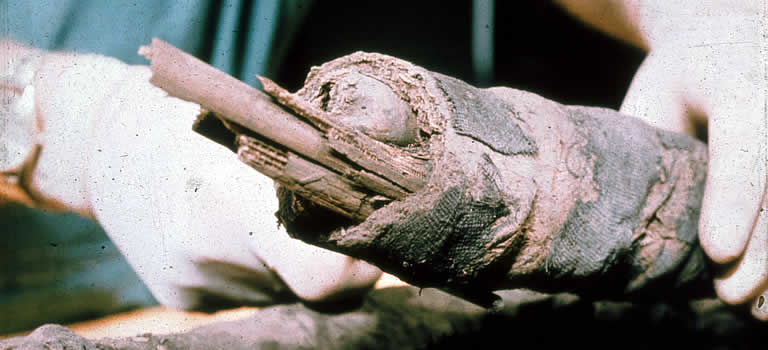Selecting Mummy 1770
As the team of researchers studying the Egyptian mummies in the Manchester Museum grew, the range of methods that could be applied also increased.
With so many different possibilities for analysis, there was a pressing need to understand how they could best be applied.
Mummies are a scarce and precious resource, so it is extremely important to know how to get the best possible results while damaging them as little as possible in the process. But all new advances need test cases and proof of concept.
Making the decision to autopsy Mummy 1770
It was decided that the best way to test the new methodology that the mummy team had devised was to try it out.
Although the destructive analysis of a mummy is not something taken lightly, and is something that is very rarely seen today, the mummy team needed a way to both test their techniques and to demonstrate that they would work and would provide accurate information.
The autopsy of a mummy would allow tried and tested visual and anatomical techniques to provide a baseline for the more advanced imaging and analytical methods that the team wanted to use in the future.
Once those methods were proven, they could be applied to other mummies with confidence that a less destructive approach would not compromise the quality or range of information that could be obtained.

This would not be the first time a mummy had been autopsied in Manchester by a multi-disciplinary team.
In 1908 Margaret Murray had assembled a team to study the mummies known as the Two Brothers, two men found buried together in a Middle Kingdom tomb. Their study represents an important stage in the history of mummy studies, helping to move it away from entertainment and more towards serious academic study.
Why was Manchester mummy 1770 selected for autopsy?
Faced with the difficult decision of which mummy to choose for the autopsy, the team chose Mummy 1770 for a combination of practical reasons. Badly preserved as the mummy was, it had never been and was unlikely to be placed on display.
Using this mummy would not mean the loss of an artefact that would be placed on the gallery for the public to see, and so would not mean the loss of an educational possibility.
The x-rays performed earlier in the project also showed that this mummy had some unusual features that meant the autopsy would not only allow new techniques to be tested, but would allow this mummy to be more thoroughly understood as both an artefact and a person.

These resources are available for use under a Creative Commons Attribution-NonCommercial-ShareAlike license (CC BY-NC-SA)


